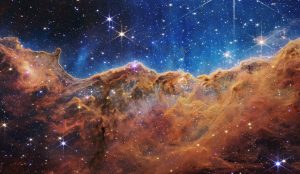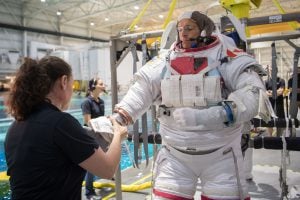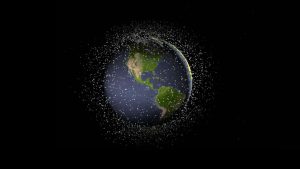
Science & Tech
James Webb Space Telescope reveals stunning first images of deep-space
A cosmic deep dive, these photographs are the deepest and sharpest full-colour images of the universe yet
- 1067 words
- 5 minutes
Science & Tech
With help from Canadian scientists, this dark universe hunter aims to study why the universe is expanding at an accelerating rate

Humans have watched over starshine for thousands of years. Constellations danced in prehistoric cave art from 40,000 years ago. The stars of the Pleiades glowed in the Nebra Sky Disc, an incredible dinner plate-sized stellar map made in the Stone Age. And Egyptians aligned their pyramids north with the belief that pharaohs became stars in the northern sky after they had died. Then, ancient Alexandrian scientists like Euclid and Ptolemy used math to chart the path of the stars.
We have come a long way since then but still have far to go.
On July 1, a new European spacecraft named Euclid was launched from Cape Canaveral, Florida, with Canada helping to charter the new lights in the dark. Like an ancient sea voyager, the Euclid spacecraft will journey to a faraway location, roughly 1.5 million kilometres away from us on the opposite side of the sun.

Flying in deep space away from the reflected light of the sun and the Earth, Euclid will spend six years seeking evidence of the “dark universe” that shapes the movements of galaxies and stars.
“The science driving Euclid is understanding dark energy,” says Will Percival, director of the University of Waterloo’s Centre for Astrophysics and primary science coordinator for the Euclid mission. “Euclid is going after the big prize of understanding that.”
For decades, physicists have been puzzled by something almost unexplainable: the universe is accelerating in its expansion. That’s “one of the big problems in physics” because gravity and visible matter can’t explain the acceleration, says Percival.
Since Isaac Newton formulated the gravitational theory in 1665, we’ve known how gravity shapes the movements of the planets, stars, and moons. Then, Albert Einstein taught us about the strange behaviours of physics at the speed of light a century ago. Yet math can’t quite account for how fast the universe is expanding, nor all the movements of big objects. We use the terms “dark energy” and “dark matter” to quickly explain each, but nuance escapes us.
Dark matter is unknown matter. It’s the stuff we can’t see with telescopes, which look at wavelengths of light from slow, heat-emitting infrared to frantic, high-energy X-rays. We best glimpse dark matter as it affects other objects – such as when a galaxy passes in front of a distant star, bending and magnifying the stellar light into a sharper view.
Dark energy describes how the universe is getting bigger, a discovery so monumental its huge team received a Nobel Prize for the work. But while we first saw the expansion through NASA’s Hubble Space Telescope and a team of other observatories, charting it with precision will require a sharper view. That’s where Euclid’s new mission comes in.
The new spacecraft will look at “weak lensing,” Percival explains, “which is the small distortions of galaxies because the light is travelling through them.” Euclid will also look for ripples in the normal matter telescopes can pick up, known as “baryonic acoustic oscillations.” You can think of these oscillations as space-time vibrating on the quantum scale, and those ripples all are influenced by how the universe rapidly grew in its infancy some 13.8 billion years ago.

Percival has spent a lifetime trying to chase that early growth. His PhD at the University of Oxford looked at how we model the life history of the universe, known as cosmology. He was in the middle of doctoral studies in 1998 when dark energy’s presence was first announced to the world. Percival says accepting this theory did not come easy to the community.
“If you have a universe, you want it to be the simplest possible universe, and the simple possible universe doesn’t have dark energy. It’s just matter, and matter that is evolving through gravity (but) that means the universe’s expansion should be decelerating. So this discovery, that it was accelerating was incredible.”
It takes decades to develop a space mission. Finding dark energy was so tough that at first, European Space Agency proposals were competing for the same funding in 2007 to look at different aspects of them. The community chose to take the brave path and combine the proposals instead of selecting only one. That gave birth to Euclid, approved in 2011 and fully funded in 2012 – with Canada as a key partner.
Percival initially came to Euclid through postdoctoral research with the Sloan Digital Sky Survey, which images the entire sky using a dedicated telescope in New Mexico. Funding for the team also came through from the Canadian Space Agency, which granted money to the University of Waterloo and the University of British Columbia through a research opportunity financing work from 2022 to 2027.

More government support is available with the National Research Council’s Herzberg Astronomy and Astrophysics Research Center. The community was so impressed by the NRC’s work on the Canada France Hawaii Telescope – especially with how they managed petabytes of data flow from the scientific facility – that NRC will now do similar work for Euclid.
“Our job is to recycle photons,” explains Stephen Gwyn, who leads NRC science in Victoria, B.C. Photons are parcels of light that are crucial to understanding how space behaves. We can precisely chart their movements by mapping photons from galaxies and stars.
Getting Euclid’s data from deep space will take a long time. First, the telescope must find room in the European Space Agency’s busy ground stations to ferry its precious haul back to our planet from deep space. Like a zip file, the data must be compressed for the long journey.
Upon arrival, the data will then be parsed and parcelled by scientists, much of it through long-established techniques like removing small distortions from the instruments. The ultimate aim is to make the data crisp and clean for scientists to map exactly how many photons came from distant space objects, to “measure the shapes of the galaxies to extremely high accuracy,” says Gwyn.
Machine learning will also kick in as the data gets parsed. An algorithm will be trained on a catalogue of billions of objects to look for anomalies. As Euclid has yet to start observing, Gwyn says we can’t predict what the mission may find. But one example of an “anomaly” could be a redshift – a galaxy moving away from us – at a speed different than the models predict.
Through spying on shifting redshift, Euclid will likely provide “an astonishing data set for understanding how galaxies evolve over most of the history of the universe,” says Douglas Scott, a cosmologist at the University of British Columbia employing two doctoral students looking at Euclid.
“There will be literally billions of galaxies in the Euclid survey, seen from the earliest times until today,” says Scott. “For a large fraction of these, we will have good redshifts, meaning that we know how far away they are and how long ago we are observing their light.”

Like people in neighbourhoods, galaxies do not evolve in isolation. Euclid aims to place galaxies and their shapes in the “cosmic web” in which they come, which refers to the large-scale structures of galaxies as they cluster in groups across the cosmic dark.
Scott says Euclid’s sharp eyes are needed now to probe what is happening out there.”We don’t really understand why galaxies have the shapes that they have, or how exactly they formed and evolve in their properties.” Without that information, it’s hard even to figure out where our planet and its neighbourhood came from – and where we will be in a few billion more years.
The spacecraft is not alone in the dark, seeking clarity on our universe’s childhood and future. Also out there in a similar orbit are NASA’s James Webb Space Telescope, which charts the growth of young galaxies, and the European Space Agency’s Gaia, which maps the movements of more than a billion stars.
Euclid’s science team is keeping its first targets under wraps. Percival says we can expect to see a few images of well-known objects to compare their capabilities to ground observatories. The rest will come from surveying the sky and slewing from spot to spot.
The wide field of Euclid is perfect for snatching large areas of the sky at once to map objects in relation to each other. Then Webb, Hubble and similar telescopes can zoom in to see what’s going on at a finer scale. Other collaborations will surely arise with Canadian observatories also peering into the universe, like CHFT or CHIME – a British Columbian telescope array that maps hydrogen gas in distant galaxies as another way to find dark energy.
For millennia, humans have tried to explain the dark of space through stories, through art and mathematics. Euclid’s telescopic eyes combine all three. It will take new interpretations of the science to truly appreciate what the dark universe is waiting to tell us, which come through careful listening to the stars – and to people.
Euclid may just reinforce the old models, Percival acknowledged. But it also may find something completely unanticipated. “That will be very exciting because that’s kind of what we’re looking for,” he says. “That will help us understand what dark energy is.”
Are you passionate about Canadian geography?
You can support Canadian Geographic in 3 ways:

Science & Tech
A cosmic deep dive, these photographs are the deepest and sharpest full-colour images of the universe yet

Exploration
A conversation with Canadian astronaut David Saint-Jacques, who is getting ready to travel to the International Space Station

Environment
Michel Doyon, manager of flight and systems operations at the Canadian Space Agency, walks us through what space debris is and its impact on Canada

Exploration
The men and women that have become part of Canada’s space team